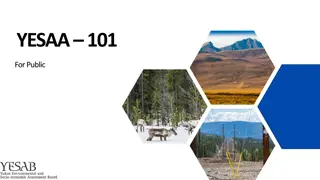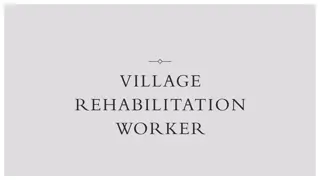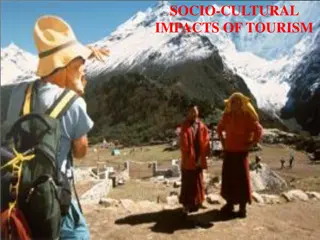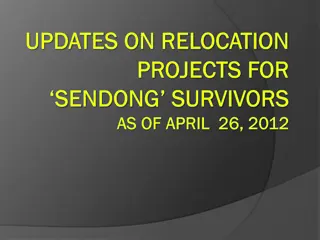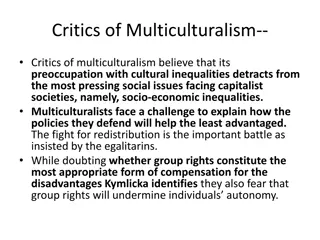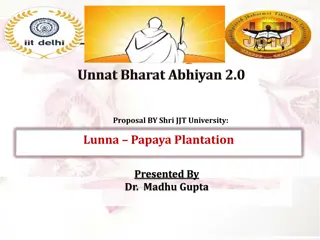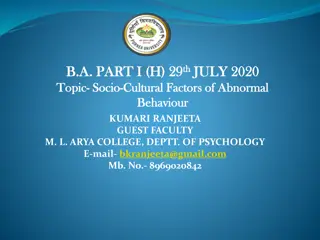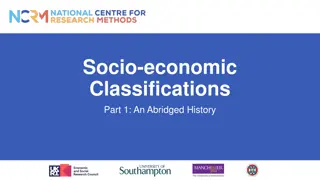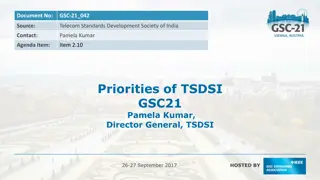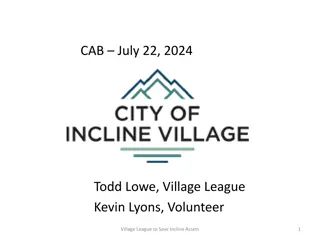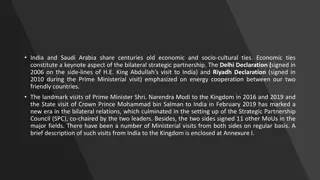Socio-Cultural Features of Village Community in India
The traditional village community in India was historically self-sufficient, with its own production and consumption units. Over time, changes have led to increased interactions among villages, diminishing self-sufficiency. Factors like multi-caste populations, markets, pilgrimages, and pilgrimages have contributed to the interconnectedness of villages. The village serves as a microcosm of caste society with distinct settlement patterns and hierarchy. The Jajmani system of exchange, based on patronage and reciprocity, has been a pillar of economic and social solidarity in villages.
Download Presentation

Please find below an Image/Link to download the presentation.
The content on the website is provided AS IS for your information and personal use only. It may not be sold, licensed, or shared on other websites without obtaining consent from the author. Download presentation by click this link. If you encounter any issues during the download, it is possible that the publisher has removed the file from their server.
E N D
Presentation Transcript
SUSMITA ROY SUSMITA ROY VILLAGE COMMUNITY IN INDIA VILLAGE COMMUNITY IN INDIA 25.08.21 25.08.21
Socio-Cultural Features of Village Community in India 1. Relative Self-Sufficiency: In the past, a traditional village was very much self-sufficient in several respects. The village was a unit of production as well as consumption. Politically there was less interference from outside world. Conflicts arising in the villages were solved in the village panchayat itself. There were also caste panchayats to give respective rights to each caste. But gradually, the village community In India has been changed. II is no more static; it has changed from time to time. According to modern anthropological studies, the village community was not and is not self-sufficient. The whole nature of the traditional society is militated against the independent isolation of a village. In earlier days there was a good deal of coming and going among villages.
There were several reasons: : i) A village is usually multi-caste. The number of castes in each village is not sufficient to carry-out the multifunctional roles a village requires, of necessity. (ii) The rule of caste endogamy was prevalent. A village, more often than not, is inhabited by a particular sub-caste of the endogamous caste group. This necessitates a villager to seek alliance from other village or villages. (iii) Markets are a major reason for travel within a locality. People from adjoining areas come to attend weekly markets and interact with one another. (iv) Village folks, specially the elderly go on pilgrimage to visit certain places like Varanasi, Dwarka, Rameswaram and so on. This brings the villagers into contact with the town people as well as the people of other places. Thus the village was never entirely a closed or self-sufficient unit.
2. Microcosm of Caste Society: The village is usually multi-caste. The pattern of Interactions among the various caste groups is governed by ritual hierarchy which in turn is manifested in rules governing, commensality, pollution, occupation and marriage. But the British rule in India gave a serious blow to the caste system in the villages. Caste panchayats became extinct. The caste system lost its traditional hold in the villages. But casteism is getting strengthened on account of selfish political interests. 3 3. Hierarchy of Settlement Pattern: The geography of a village follows a fixed pattern. Each caste usually has a separate settlement ward. In Gujarat, such areas are called Phaliya , In Karnataka it is Keri , in Maharashtra it is Wada . Everywhere we find the so called untouchables and Dalits live separately from the caste Hindus. The members of a ward show a strong sense of unity. Inter ward disputes occur occasionally like inter-village disputes.
4 4. Jajmani as a system of exchange: It has been the basis of economic, social and cultural solidarity in the villages. It involved both the relationship of dominance and reciprocity. Under this system some castes are patrons (Jajman) and other are service castes (Kameen). These service castes generally under obligation to serve I he patron castes and their families. But now-a-days, this system has been weakened due to the influence of market forces, migration, contacts with towns, impact of education etc. 5 5. Village Solidarity: People live in villages with close proximity and close interaction among them. They share the same familiar life-space, share the common experiences of natural forces/disasters/ calamities etc. A villager s closest economic associates are within his village. The villagers have separate hearths and common home. Mandelbaum Their very life experiences develop a sense of unity and identity. This sense of solidarity is reflected in various contexts. Village solidarity is commonly expressed in village ceremonies. Ritual occasions, for example the life-cycle ceremonies require the co-operation of several castes. The functioning of the village as a political and social entity brings together members of all castes.
6. Religion: Religion provides the woof and worf of the community life in a village. The Hinduism that they follow is neither of the high spiritual order nor of the abstract intellectual type, nor even of the popular puranic nature. They worship number of Gods and goddesses such as Durga-Kali, Lakshmi, Saraswati etc. People also worship the village deities. They also worship trees, especially Pipal and the Tulsi Beliefs in ghosts and witches are also prevalent. Temple-the place of worship is also a place where the people from all castes get together to celebrate religions and social occasions. It is a place of congregation. Festivals are also celebrated in each and every village with pump and ceremony. Festivals strengthen the association of castes in the villages.
7.Factionalism: Every village witnesses elements of factionalism in its daily round of activities. There are many basis of factionalism such as economic, kinship ties, caste affiliation, new political consciousness etc. With the breakdown of Jajmani relations, many kamin (castes) have shifted their allegiance to new groups usually outside the village namely urban businessmen. Modern politics has led to the strengthening of what sociologists call horizontal solidarity that is solidarity of caste. Now castes belonging to different villages come together to act as pressuregroup . This has special bearing on the traditional power structure. Improved means of transport and communication system have further consolidated this trend towards factionalism.
The Village Community: The earliest human communities were perhaps the loosely organised aggregations of a few families who carried on mutually interdependent activities in gathering food and defending themselves against their enemies. These primitive bands were migratory communities. Gradually man acquired skill and knowledge in agriculture. With the development of agriculture and the consequent stabilization of the source of food, the people began to lead a settled life and human communities became more stationary. The village emerged which signified that man has passed from nomadic mode of collective life to the settled one. It is difficult to form a precise definition of the term village . Generally it is understood to mean a small area with small population which follows agriculture not only as an occupation but also as a way of life.
Evolution of Village Community: The village community has passed through the following stages: (i) Primitive Village Community: There are two peculiar features of the primitive village community; first, the part played by kinship and, second, its collectivist basis. The ancient village community was a very small group of ten or twenty families. Owing to smallness of size everybody knew each other. (ii) Medieval Village Community: The primitive village community underwent a fundamental change by the time of the middle Ages. Neither kinship any longer played a prominent part in binding the people nor did the land belong to the group as a whole. Instead, feudal system came into existence. The land now belonged to a lord of some sort, to the king, to a member of the nobility or to an ecclesiastical chief.
( (iii) Modern Village Community: With the rise of industrialism in modern times the rural group began to lose its importance. Now urban group began to dominate civilization. However, in spite of growth of urbanism it is a fact that even at the present time a large proportion of population lives in villages. In India, about 75 per cent of the population lives in villages. The modern village community stands in sharp contrast to the primitive one. Urbanization, the dominant feature of the modern age has made its impact on the village community. The modern city has set the pattern of the rural way of life. Rural social forms have been changing. The rural people have taken over the urban forms of life. The kinship bond, a peculiar feature of the primitive village community, has been broken due to the increased size and mobility of population. The land is no longer owned collectively or cultivated jointly. Even the methods of working the land have taken on urban characteristics.
Features of Village Community: The village community is marked by several features. The important ones are the following: (i) Community Consciousness: The village dwellers have a sense of unity. The relations between the village people are intimate. They personally know each other. Their customs, conventions and culture are common. They jointly take part in religious celebrations. Structurally and functionally the village is a unit. (ii) Role of Neighbourhood: In a village neighbourhood is of great importance. There is not enough of individuality and speed in the life of the village to disable one from paying attention to his neighbour his sorrow, and joys. In the village people assist each other and thus they have closest neighbourhood relations. (iii) Joint Family: Though in the cities the joint family system is breaking down, yet in the villages it still retains its hold. The agricultural occupation requires the cooperation of all the family members. The men plough the field, the women harvest the crops and the children graze the cattle.
( (iv) Faith in Religion: The people in the villages have deep faith in religion and deities. Their main occupation is agriculture which largely depends upon the vagaries of nature. The farmer acquires an attitude of fear and awe towards natural forces and starts worshipping them. (v) Simplicity: The village people lead a simple life. It is not ostentatious. They are far away from the evils of modern civilization. They are a simple and plain people believing in God. They do not show pretensions. Their behaviour is natural and not artificial. They live a peaceful life. They are free from mental conflicts. They do not suffer heart strokes. They are sincere, hospitable and hardworking. The level of morality is high. Social crimes are very rare. Their life is governed by norms.
Growth of Village Community: The growth of village community depends upon the following factors: (i) Topographical Factors: Among the topographical factors are included land, water and climate. It is obvious that these factors influence the growth of village community. Land is the most important topographical factor. People would like to settle at a place where land is fertile and plain. It is difficult to carry agriculture on land which is rocky and uneven. If the land is not fertile and is sandy the villages cannot develop there. In the rocky areas and in deserts habitation is scarce. On the other hand, in the plain and fertile lands of Punjab one can observe villages at every two or three miles. The villages settled on fertile lands are more developed and prosperous. The villages in the mountainous areas are not so prosperous.
(ii) Economic Factors: Among the economic factors we may include the condition of agriculture, rural economy and cottage industries. Agriculture is the mainstay of the village community. As such the growth of village community depends upon the condition of agriculture. If farming yields a good crop, the economic condition of the village people will be better. If, on the other hand, they have to exert themselves to the point of exhaustion just to get enough for two meals a day, their economic and social condition will not be better. In those countries where scientific inventions and favourable natural conditions have increased the agricultural production the village communities are in an advanced stage of development. In India, the village communities are poor because of low agricultural production.
(iii) Social Factors: Among the social factors went include peace, security, cooperation and intelligence etc. For the development of the village community it is essential that there must be peace in the village. Besides peace, the village people must be guaranteed security security from disease, and in agriculture. They also need security against natural calamities. Agriculture Insurance can give them this sense of security. Community development is not possible without cooperation. In the village there are many activities which depend upon cooperation of the whole community. Such activities, for example, are public health and sanitation, peace and order, proper use of public amenities, education and recreation, etc. Through cooperation the village people can bring about their development and put the village community on the way to prosperity. Ultimately, the growth of the village community depends upon the intelligence of the villagers. Lacking intelligence they cannot raise the agricultural output nor profit by the scientific discoveries. The village communities in the west are prosperous because they are intelligent. In India the villages are in a backward state because the village people lack intelligence to make use of scientific discoveries.




